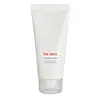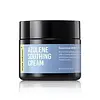What's inside
What's inside
 Key Ingredients
Key Ingredients

No key ingredients
 Benefits
Benefits

 Concerns
Concerns

 Ingredients Side-by-side
Ingredients Side-by-side

Water
Skin ConditioningPanthenol
Skin ConditioningPentaerythrityl Tetraethylhexanoate
EmollientCoco-Caprylate/Caprate
EmollientPentylene Glycol
Skin ConditioningPotassium Cetyl Phosphate
Emulsifying1,2-Hexanediol
Skin ConditioningCetearyl Olivate
Cetearyl Alcohol
EmollientSorbitan Olivate
EmulsifyingAmmonium Acryloyldimethyltaurate/Vp Copolymer
Glyceryl Stearate Se
EmulsifyingMethyl Methacrylate Crosspolymer
Carbomer
Emulsion StabilisingEthylhexylglycerin
Skin ConditioningDisodium EDTA
Guaiazulene
AntimicrobialWater, Panthenol, Pentaerythrityl Tetraethylhexanoate, Coco-Caprylate/Caprate, Pentylene Glycol, Potassium Cetyl Phosphate, 1,2-Hexanediol, Cetearyl Olivate, Cetearyl Alcohol, Sorbitan Olivate, Ammonium Acryloyldimethyltaurate/Vp Copolymer, Glyceryl Stearate Se, Methyl Methacrylate Crosspolymer, Carbomer, Ethylhexylglycerin, Disodium EDTA, Guaiazulene
Water
Skin ConditioningButylene Glycol
HumectantCetyl Ethylhexanoate
Emollient1,2-Hexanediol
Skin ConditioningPolysorbate 60
EmulsifyingGlycerin
HumectantCaprylic/Capric Triglyceride
MaskingCoco-Caprylate/Caprate
EmollientGuaiazulene
AntimicrobialCentella Asiatica Extract
CleansingAsiaticoside
AntioxidantMadecassic Acid
Skin ConditioningAsiatic Acid
Skin ConditioningMadecassoside
AntioxidantPolyacrylate-13
Cetyl Alcohol
EmollientStearyl Alcohol
EmollientAcrylates/C10-30 Alkyl Acrylate Crosspolymer
Emulsion StabilisingPolyisobutene
Glyceryl Stearate
EmollientBeeswax
Emulsion StabilisingTromethamine
BufferingPalmitic Acid
EmollientStearic Acid
CleansingXanthan Gum
EmulsifyingPolysorbate 20
EmulsifyingEthylhexylglycerin
Skin ConditioningSorbitan Isostearate
EmulsifyingAdenosine
Skin ConditioningSodium Hyaluronate
HumectantAllantoin
Skin ConditioningPanthenol
Skin ConditioningOenothera Biennis Oil
EmollientCeramide NP
Skin ConditioningPersea Gratissima Oil
Skin ConditioningCalamine
AbsorbentMelaleuca Alternifolia Leaf Oil
AntioxidantSimmondsia Chinensis Seed Oil
EmollientCupressus Sempervirens Oil
MaskingButyrospermum Parkii Butter
Skin ConditioningBetula Platyphylla Japonica Juice
Skin ConditioningGlycyrrhiza Glabra Root Extract
BleachingPropanediol
SolventCamellia Japonica Flower Extract
EmollientAloe Barbadensis Leaf Extract
EmollientCalendula Officinalis Extract
Skin ConditioningChamomilla Recutita Extract
Skin ConditioningMentha Rotundifolia Leaf Extract
TonicLavandula Angustifolia Flower Extract
CleansingCitric Acid
BufferingDisodium EDTA
Water, Butylene Glycol, Cetyl Ethylhexanoate, 1,2-Hexanediol, Polysorbate 60, Glycerin, Caprylic/Capric Triglyceride, Coco-Caprylate/Caprate, Guaiazulene, Centella Asiatica Extract, Asiaticoside, Madecassic Acid, Asiatic Acid, Madecassoside, Polyacrylate-13, Cetyl Alcohol, Stearyl Alcohol, Acrylates/C10-30 Alkyl Acrylate Crosspolymer, Polyisobutene, Glyceryl Stearate, Beeswax, Tromethamine, Palmitic Acid, Stearic Acid, Xanthan Gum, Polysorbate 20, Ethylhexylglycerin, Sorbitan Isostearate, Adenosine, Sodium Hyaluronate, Allantoin, Panthenol, Oenothera Biennis Oil, Ceramide NP, Persea Gratissima Oil, Calamine, Melaleuca Alternifolia Leaf Oil, Simmondsia Chinensis Seed Oil, Cupressus Sempervirens Oil, Butyrospermum Parkii Butter, Betula Platyphylla Japonica Juice, Glycyrrhiza Glabra Root Extract, Propanediol, Camellia Japonica Flower Extract, Aloe Barbadensis Leaf Extract, Calendula Officinalis Extract, Chamomilla Recutita Extract, Mentha Rotundifolia Leaf Extract, Lavandula Angustifolia Flower Extract, Citric Acid, Disodium EDTA
Ingredients Explained
These ingredients are found in both products.
Ingredients higher up in an ingredient list are typically present in a larger amount.
1,2-Hexanediol is a synthetic liquid and another multi-functional powerhouse.
It is a:
- Humectant, drawing moisture into the skin
- Emollient, helping to soften skin
- Solvent, dispersing and stabilizing formulas
- Preservative booster, enhancing the antimicrobial activity of other preservatives
Coco-Caprylate/Caprate is created from fatty coconut alcohol, caprylic acid, and capric acid.
It is a lightweight emollient. Emollients create a thin barrier on the skin to trap moisture in. This helps keep your skin hydrated and soft.
Once applied, Coco-Caprylate/Caprate is absorbed quickly and leaves a silky feel.
Coco-Caprylate/Caprate may not be fungal acne safe.
Learn more about Coco-Caprylate/CaprateDisodium EDTA plays a role in making products more stable by aiding other preservatives.
It is a chelating agent, meaning it neutralizes metal ions that may be found in a product.
Disodium EDTA is a salt of edetic acid and is found to be safe in cosmetic ingredients.
Learn more about Disodium EDTAEthylhexylglycerin (we can't pronounce this either) is commonly used as a preservative and skin softener. It is derived from glyceryl.
You might see Ethylhexylglycerin often paired with other preservatives such as phenoxyethanol. Ethylhexylglycerin has been found to increase the effectiveness of these other preservatives.
Guaiazulene is a fragrance.
Panthenol is a common ingredient that helps hydrate and soothe the skin. It is found naturally in our skin and hair.
There are two forms of panthenol: D and L.
D-panthenol is also known as dexpanthenol. Most cosmetics use dexpanthenol or a mixture of D and L-panthenol.
Panthenol is famous due to its ability to go deeper into the skin's layers. Using this ingredient has numerous pros (and no cons):
Like hyaluronic acid, panthenol is a humectant. Humectants are able to bind and hold large amounts of water to keep skin hydrated.
This ingredient works well for wound healing. It works by increasing tissue in the wound and helps close open wounds.
Once oxidized, panthenol converts to pantothenic acid. Panthothenic acid is found in all living cells.
This ingredient is also referred to as pro-vitamin B5.
Learn more about PanthenolWater. It's the most common cosmetic ingredient of all. You'll usually see it at the top of ingredient lists, meaning that it makes up the largest part of the product.
So why is it so popular? Water most often acts as a solvent - this means that it helps dissolve other ingredients into the formulation.
You'll also recognize water as that liquid we all need to stay alive. If you see this, drink a glass of water. Stay hydrated!
Learn more about Water